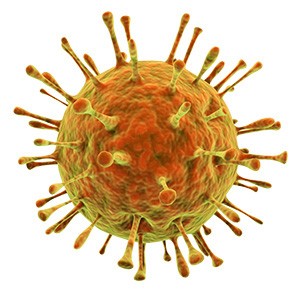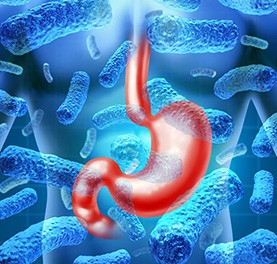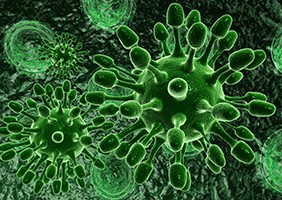Culturing the First Human Norovirus: The Road to a Cure
by Kerry Connell
Few things can spoil a relaxing vacation on a cruise ship like viral gastroenteritis. Every so often, news reports tell the tale of a luxury liner that has become a scene of misery for hundreds of unfortunate people. The illness is highly contagious and usually includes nausea, vomiting, diarrhea, and pain. Norovirus is to blame for these intensely unpleasant reactions and, so far, there is no cure. But that may be about to change.
A Widespread Scourge

Not all norovirus infections occur on ships—hospitals, retirement homes, hotels, restaurants, and schools are also prime transmission locations because they bring large numbers of people into close quarters. The main transmission route is fecal-oral, but norovirus also spreads quite efficiently from person to person and by infected food, water, air, and surfaces.
Sometimes erroneously called the "stomach flu," norovirus illness is not related in any way to the influenza virus, and it is different from food poisoning as well. (Norovirus actually brings about more foodborne illness in the United States than E. coli and Salmonellaenterica combined.)
Every year in the United States, norovirus causes about 20 million cases of illness and 56,000 to 71,000 hospitalizations. About 570 to 800 people in the U.S. die each year from acute gastroenteritis caused by norovirus. There is no immunity; norovirus can infect people again and again. Even worse, people who have had norovirus illness and then recover remain contagious for up to three days after their symptoms have subsided. The current "treatment" for norovirus consists of simple rehydration in severe cases, and vaccine development (now in clinical trials) has been slow thanks to the many different strains of norovirus that affect humans
A medication that fights active norovirus illness would eliminate a great source of suffering. In the June 26, 2014 issue of The LancetInfectious Diseases, scientists estimate norovirus to be the cause of 18 percent of all cases of acute gastroenteritis worldwide, based on an analysis of data from 48 countries. This, the largest study of norovirus infection and disease ever conducted, also found that norovirus is responsible for 14 to 19 percent of all acute gastroenteritis cases in developing countries and 20 percent in developed countries. These numbers highlight the fact that improved water conditions and sanitation are not enough to control the spread of norovirus. Norovirus is the leading cause of severe childhood diarrhea in the United States, and dehydration due to norovirus-related diarrhea is also a leading cause of death among children of the developing world.
Tiny, insidious, and strong

Norovirus is resistant to most common disinfectants and alcohol-based sanitizers because, unlike most viruses, it lacks a lipid envelope. Alcohol easily penetrates the lipid envelope of other viruses, killing them, but norovirus has a tough shell of protein. The protein envelope also protects the norovirus when it is no longer within a host organism. Most viruses die when they are exposed because they become vulnerable to the elements when the lipid envelope dries, but the protein envelope of the norovirus allows it to live in the wild for weeks or even months.
Only a very small sample—as few as 18 viral particles, or virions—is needed to cause infection, according to Dr. Benjamin Lopman from the Centers for Disease Control and Prevention. To put that in perspective, a single gram of an infected person's stool can contain more than a billion virions. The average norovirus virion is only 35 nanometers in width, or a third the size of other viruses.
42 years—and then a breakthrough
Since its discovery in 1972, norovirus has been in science's cross-hairs—but so far, no treatment has been developed. This is because of the difficulty of culturing the human strain of norovirus in a cell culture dish. Dr. Stephanie Karst, an associate professor of molecular genetics and microbiology at the University of Florida College of Medicine, says the problem "…complicates every aspect of research. We can’t study how it replicates, we can’t test therapeutics, and we can’t generate live virus vaccines.” But she and her research team have overcome those challenges.
Existing mouse studies "led us to develop the first cell culture system for a human norovirus specifically infecting human B cell lines in the presence of appropriate intestinal bacteria," Karst states. That means that, for the first time, scientists have grown a human norovirus cell in a culture dish. In an article in Science entitled "Enteric bacteria promote human and mouse norovirus infection of B cells," Karst and her colleagues explain how norovirus takes hold in the human body.
From mice to men

Studies before the development of this historic human norovirus culture came close to discovering the mechanism by which norovirus works. Early research suggested that norovirus targets the epithelial cells of the intestine, which line the intestinal wall and protect it from pathogens, but conclusions were hard to come by because noroviruses have always been difficult to study. "The primary roadblock to studying them has been that we haven’t been able to grow them in the laboratory," notes Karst on the November 7, 2014 Science podcast. "So, we haven't had a cell culture system with which to amplify the virus."
In July 2013, researchers created an animal model of the human norovirus in order to study the feasibility of creating antiviral compounds. Dr. Christine Wobus, an assistant professor in the department of microbiology and immunology at the at the University of Michigan Medical School, grew human norovirus in mice that had been modified with human immune cells to be interferon-deficient and interleukin 10–deficient. Her research revealed that the virus infected the mice in virus-positive cells in the B cell (or B lymphocyte) zones of Peyer’s patches, elongated lymphoid follicles that line the ileum and are essentially the basis of the adaptive immune system of the intestine.
In human adults, B cells predominate in the germinal centers of these structures. The study also found that mice with deficiencies of the B cells exhibited reduced virus titers when compared with wild-type mice, further suggesting that norovirus targets B cells in vivo. B cells differ from other lymphocytes by the presence of a protein known as a B cell receptor (BCR), which allows the B cell to bind to a specific antigen. The antigen-recognition molecules of B cells are the immunoglobulins, or Ig—proteins that B cells produce in a range of antigen specificities—so, the BCR is a membrane-bound immunoglobulin on the B cell surface. Differentiated B cells (plasma cells) secrete immunoglobulin of the same antigen specificity as an antibody, which binds pathogens and contributes to adaptive immunity.
Karst's research team at the University of Florida took note of Wobus's study of mouse noroviruses. "Other types of immune cells, in particular macrophages and dendritic cells, supported infection," says Karst. "But those didn’t seem to be targets for the human virus. One observation that my lab made quite a few years ago is that when we stained intestinal sections of mice infected with mouse noroviruses, we could detect viral antigen in B cells along the intestinal tract." (A similar study in chimpanzees by the National Institutes of Health bore out this finding for human norovirus models.)
Karst and her team infected mouse B-cell lines with two different strains of mouse norovirus, either MNV-1 or MNV-3. MNV-1 establishes an acute infection, whereas MNV-3 establishes persistence; MNV-3 is attenuated compared with MNV-1. Both strains were seen to persistently infect the B cells of Peyer's patches in mice.
They then infected human BJAB-line B cells via positive stool sample with the dominant strain of human norovirus, known as GII.4-Sydney, and observed a significant increase in viral genome copy number. Viral genome replication and protein synthesis in BJAB cells indicates productive infection, meaning that BJAB infection results in the production of new infectious virus particles. Filtration of the stool sample decreased genome replication, which suggested the presence of a filterable cofactor. No increase in viral genome copy number was detected in cells infected with unfiltered stool.
The reason this B-cell targeting works is unclear. "It would seem surprising that infection of a B cell would have such dramatic effects on the intestinal epithelium," says Karst. "So one thing that we wonder is whether virus being secreted from the B cell—or some virus protein secreted from the B cell—is having effects on the overlying epithelial cells, which is actually the pathogenic mechanism that leads to the disease."
Karst's team was already aware of the tendency of norovirus to bind to histo-blood group antigens (HBGAs), which are expressed by the host as well as by certain bacteria in the gut. Writing in the Japanese Journal of Infectious Diseases in 2011, H. Shirato, of the Department of Virology at the National Institute of Infectious Diseases, in Tokyo, explains that norovirus forms antigenically diverse groups, most of which bind to the HBGAs known as the ABH antigens and Lewis antigens. These are characterized by carbohydrate core structures that constitute antigenically distinct phenotypes. Carbohydrate binding is essential for infection, so the type of antigen expressed in the gut determines the strain of norovirus to which an individual is susceptible. "Although it is still unclear whether HBGAs act as primary receptors or enhance norovirus infectivity," writes Shirato, "they are important factors in determining tissue specificity and the risk of transmission."
Karst and her team revisited this connection in their study. They first tested Enterobacter cloacae because it expresses H-type HBGA, which the GII.4-Sydney human norovirus strain can bind. Filtered stool containing the virus showed restored infectivity when incubated with E. cloacae before inoculation of BJAB B cells, but neither Escherichia coli (which does not express H antigen) nor lipopolysaccharide (LPS, a component of the outer membrane of Gram-negative bacteria) did so. Synthetic H antigen, however, restored infectivity of filtered stool comparably with E. cloacae. Karst writes that these results "demonstrate that (human norovirus) interactions with enteric bacteria, likely through binding to bacterially expressed HBGAs, facilitate productive attachment to, and infection of, B cells."
In short, "susceptibility to individual human norovirus strains correlates with an individual’s histo-blood group antigen (HBGA) profile". Therefore, normal bacteria in the gut known as commensal bacteria, or HBGA-expressing enteric bacteria, are the key to this ability of norovirus to infect B cells.
Busy bacteria

Norovirus requires a particular variety of carbohydrate in order to infect cells, and commensal bacteria possess that very carbohydrate. "What we’ve shown is that noroviruses attach to that carbohydrate expressed on commensal bacteria, and that this interaction stimulates viral infection of the B cell," Karst says. "This is a really exciting, emerging theme. A variety of intestinal viruses seem to exploit the bacteria that are present in our intestines all the time. These viral infections are enhanced by the presence of bacteria in the gut."
A great deal of the research on gut microflora suggests that the bacteria normally present in the microbiome tend to help people fight infection, not the other way around. Immunologists at Georgia State University recently prevented and cured a rotavirus infection in mice using cultures from gut bacteria. (Like norovirus, rotavirus causes diarrhea and vomiting.) And in the May 2004 issue of Immunology Letters, researchers note that commonsal bacteria are important in the development of an optimally functioning mucosal immune system.
But research has also established the ability of gut flora to enhance the tendency of other organisms to promote disease. The mucosal immune system of the intestinal tract is "heavily colonized by approximately 1014 commensal microorganisms, which live in symbiosis with their host. These bacteria are beneficial to their host in many ways. They provide protection against pathogenic bacteria by occupying the ecological niches for bacteria in the gut…However, in certain circumstances they can also cause disease." (Janeway C.A. Jr., Travers P, Walport M, et al. (2001) Immunobiology: The Immune System in Health and Disease. 5th edition New York: Garland Science) Indeed, Karst's team also found that norovirus replication in mice was reduced in vivo when oral antibiotics depleted the intestinal microbiota.
An answer, and more questions
"We have identified B cells as a cellular target of noroviruses and enteric bacteria as a stimulatory factor for norovirus infection," Karst writes. "We have developed a cell culture system for (human norovirus) by revealing that the current globally dominant GII.4-Sydney human norovirus strain infects human B cells. This infection is substantially enhanced by free HBGA or by HBGA-expressing bacteria. It is thus likely that previous attempts to culture (human norovirus) failed because of the nature of the cell type tested and the absence of stimulatory carbohydrate molecules. Animal studies…validate that intestinal B cells are in vivo targets…and that enteric bacteria are required for efficient infection of susceptible hosts."
With HBGA-expressing bacteria so close to Peyer's patches and B cells in the intestine, norovirus is easily able to find what it needs in order to replicate and cause acute gastroenteritis. Now, scientists must learn how these variables work together. "We have garnered clues from our work…the system that we've set up is still unfortunately not very efficient so there are still mysteries to be solved," says Karst. But by putting the two biggest pieces of information together—the identification of the B cell as the primary target and the importance of the carbohydrate expressed by the bacteria—they are well on their way.
A possible cure?

Now that researchers know what norovirus requires in order to infect humans, they are in a position to explore the interactions of those factors and use the knowledge they gain to develop therapeutic interventions.
The necessity of a bacterial presence for this infection may suggest that antibiotic therapy would reduce acute gastroenteritis caused by norovirus, but because the intestinal bacteria help to maintain intestinal homeostasis (even during an active infection), this is probably not a sensible approach. Furthermore, scientists do not know which of the many varieties of intestinal bacteria are responsible for promoting and supporting the action of norovirus. A better way to treat the disease would be to stop the virus from replicating.
With the human norovirus culture, says Karst, "We can now test antiviral drugs to see whether they block replication of the virus. We can test the functionality of antibodies, seeing whether they can neutralize viral infectivity." This would also be the key to designing an effective vaccine.
In the future, we may see a medication that is capable of rendering norovirus ineffective before it has the ability to cause full-blown acute gastroenteritis—an achievement that would vastly reduce human suffering on a global scale.
